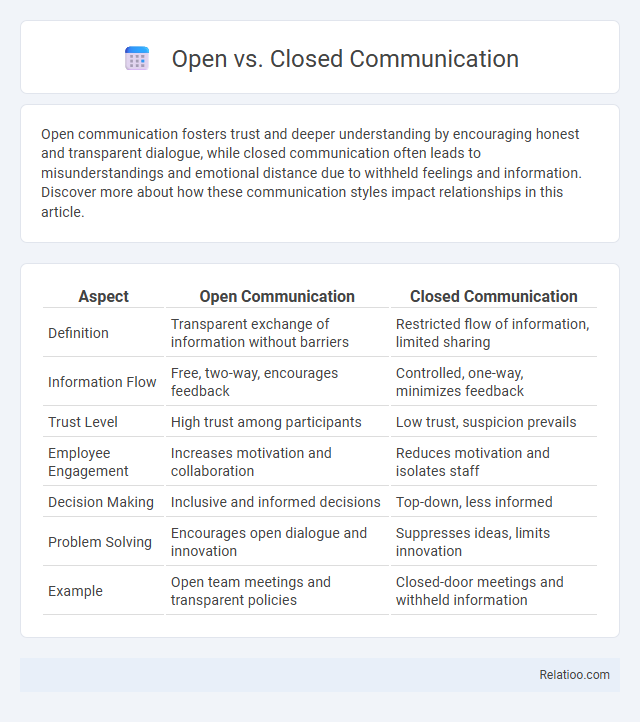Open communication fosters trust and deeper understanding by encouraging honest and transparent dialogue, while closed communication often leads to misunderstandings and emotional distance due to withheld feelings and information. Discover more about how these communication styles impact relationships in this article.
Table of Comparison
| Aspect | Open Communication | Closed Communication |
|---|---|---|
| Definition | Transparent exchange of information without barriers | Restricted flow of information, limited sharing |
| Information Flow | Free, two-way, encourages feedback | Controlled, one-way, minimizes feedback |
| Trust Level | High trust among participants | Low trust, suspicion prevails |
| Employee Engagement | Increases motivation and collaboration | Reduces motivation and isolates staff |
| Decision Making | Inclusive and informed decisions | Top-down, less informed |
| Problem Solving | Encourages open dialogue and innovation | Suppresses ideas, limits innovation |
| Example | Open team meetings and transparent policies | Closed-door meetings and withheld information |
Understanding Open vs Closed Communication
Open communication encourages transparency and active sharing of thoughts, promoting a collaborative environment that fosters trust and clarity. Closed communication restricts information flow, often leading to misunderstandings and reduced team efficiency, as crucial details remain undisclosed. Your ability to recognize when to engage in open versus closed communication significantly impacts relationship-building and boundary setting in both personal and professional contexts.
Key Characteristics of Open Communication
Open communication is characterized by transparency, active listening, and mutual respect, fostering an environment where ideas and feedback flow freely. It encourages honesty and trust, enabling team members to express concerns and collaborate effectively without fear of judgment. This approach contrasts with closed communication, which limits information exchange and creates barriers, while boundaries define the appropriate scope and limits for interaction within professional or personal contexts.
Defining Features of Closed Communication
Closed communication is characterized by limited information exchange, restricted feedback, and a controlled flow of messages often dictated by authority figures. This communication style emphasizes confidentiality and reduces openness, leading to minimal participation and less transparency among members. Boundaries in closed communication are rigid, protecting private or sensitive information but potentially hindering collaboration and trust.
Benefits of Open Communication in Organizations
Open communication in organizations fosters transparency, builds trust among employees, and stimulates collaboration by encouraging the free exchange of ideas and feedback. It enhances problem-solving efficiency and innovation by allowing diverse perspectives to surface and be addressed promptly. Organizations with open communication cultures often experience higher employee engagement, reduced misunderstandings, and stronger alignment with organizational goals.
Risks and Downsides of Closed Communication
Closed communication in organizational settings increases the risk of misinformation and misunderstandings due to limited information flow. It creates barriers that hinder collaboration, reduce trust, and foster a culture of secrecy, which can escalate conflicts and decrease employee morale. This communication style often results in missed opportunities for innovation and problem-solving, as critical feedback and diverse perspectives remain unshared.
Impact on Team Collaboration and Productivity
Open communication fosters transparency and trust, enhancing team collaboration by encouraging idea sharing and problem-solving. Closed communication restricts information flow, often leading to misunderstandings, reduced morale, and decreased productivity. Maintaining clear boundaries helps define roles and responsibilities, preventing conflicts and ensuring focused, efficient teamwork.
Real-World Examples: Open vs Closed Communication
Open communication fosters transparency and trust, exemplified by collaborative teams in companies like Google encouraging idea sharing and feedback, leading to innovation and employee engagement. Closed communication, seen in hierarchical organizations with strict information control, can result in misunderstandings and reduced morale, such as in traditional military settings where information flow is tightly regulated. Understanding how open and closed communication affect your workplace dynamics helps improve collaboration and decision-making effectiveness.
Choosing the Right Approach for Your Workplace
Choosing the right communication approach in your workplace involves understanding the differences between open, closed, and boundary communication styles. Open communication encourages transparency and collaboration, fostering trust and innovation, while closed communication limits information flow to maintain control and reduce risks. Boundary communication strikes a balance by clearly defining what information is shared and with whom, helping you manage confidentiality and build a respectful, efficient work environment.
Strategies to Foster Open Communication
Effective strategies to foster open communication include actively encouraging feedback, demonstrating empathy, and maintaining transparency to build trust within teams. Establishing clear boundaries ensures that conversations remain respectful and focused, preventing misunderstandings while promoting psychological safety. By prioritizing these approaches, you create an environment where open dialogue thrives, enhancing collaboration and organizational success.
Overcoming Barriers to Effective Communication
Open communication encourages transparency and trust, allowing Your message to be clearly understood and reducing misunderstandings caused by psychological or physical barriers. In contrast, closed communication restricts information flow, often leading to misinterpretations and conflict, while boundaries define the limits of acceptable interaction to maintain respect and clarity. Overcoming barriers to effective communication involves fostering open dialogue, respecting personal and professional boundaries, and actively addressing factors such as cultural differences, noise, and emotional states that hinder message delivery.

Infographic: Open vs Closed Communication
 relatioo.com
relatioo.com